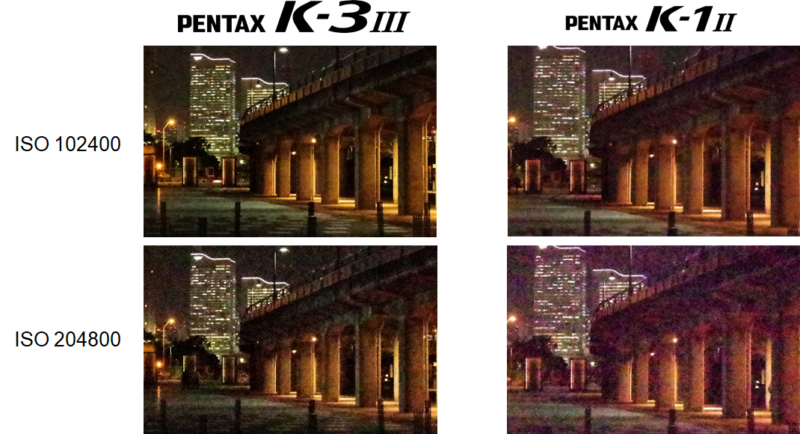Hi everyone! I’m Shigeru Wakashiro, in charge of planning and development for PENTAX digital SLR cameras.
Although I talk about it in the K-3 Mark III product information video, I’d once again like to touch on the image quality of the PENTAX K-3 Mark III.
We completely redesigned all of the components that affect image quality, to further improve the camera’s imaging performance, not only in the high-sensitivity range, but in the low-sensitivity range as well. To do this, we selected a high-sensitivity, back-illuminated CMOS image sensor, which assured excellent light reception efficiency. Its roughly 25.73 effective megapixels and AA (anti-aliasing)-filter-free optical design mean that this APS-C-sized sensor will produce high-resolution, high-quality images. In addition, the newly developed PRIME V imaging engine and new-generation accelerator unit work together to perform complex image-processing operations with great efficiency, assuring both enjoyable camera operation and exceptional image quality.


In developing image quality at PENTAX, one of our most important tasks is in maintaining consistency in image rendition across the camera’s entire ISO sensitivity range. This means that, regardless of how the ISO sensitivity fluctuates, the camera must produce similar rendition of the image at all sensitivity levels. To achieve this, we had to fine-tune the camera by optimizing the consistency in noise and sharpness. Working to minimize the generation of chromatic noise in the high-sensitivity range sometimes results in unfaithful color reproduction. We were able to develop an original image processing technology that assured distinctive PENTAX rendition even at super-high sensitivities. In the PENTAX K-3 Mark III, we moved a step closer to achieving the ideal PENTAX image quality by incorporating the PRIME V imaging engine and the new-generation accelerator. While delivering beautiful images with smooth outlines and true-to-life colors, the camera also prevents incorrect adjustment of black levels. It even provides a super-high top sensitivity of ISO 1,600,000. Because it also provides a selection of Custom Image modes and a wide range of adjustable parameters, the number of combinations with ISO sensitivity settings is almost limitless. By conducting a series of sensibility evaluations to analyze a great number of images captured by our image quality designers, and by using the evaluation results for further upgrading, we were able to successfully fine-tune the camera and produce consistent image rendition at all ISO sensitivity levels.
Although image resolution is basically determined by the number of recording pixels in the image sensor, the final image resolution of the captured image is most affected by the tuning of the imaging engine. For more faithful reproduction of subject texture, the previous models provided a choice of three sharpness enhancing modes: standard Sharpness, Fine Sharpness and Extra Sharpness. The Standard Sharpness mode emphasizes the subject’s solid outlines, but sometimes fails to detect fine outlines. The Fine Sharpness mode clearly expresses delicate outlines, but it tends to emphasize noise factors. The Extra Sharpness mode depicts delicate outlines more clearly, but it tends to further intensify noise factors, and may even generate unwanted false noise. Since each mode has its own plusses and minuses, we decided to provide all three modes to provide you with a choice, depending on your subject or application.
Newly developed for the PENTAX K-3 Mark III, the Fine Sharpness II mode faithfully reproduces delicate outlines just like the Extra Sharpness mode, but it also minimizes the generation and emphasis of unwanted noise, while reproducing fine textures and subtle gradations in the subject with greater accuracy. In fact, at PENTAX we see this mode as depicting subject texture at a level close to perfection. Created by integrating the Fine Sharpness and Extra Sharpness modes, this new mode is incorporated into the PENTAX K-3 Mark III — and will be in future PENTAX SLR models — as the default setting.
Thanks to all these advanced features, you will realize the great improvement in image resolution and reproduction of subject texture in the low-sensitivity range when you capture image with the PENTAX K-3 Mark III.
You begin using your imagination the moment you see a subject, then release the shutter and anticipate the resulting image. I believe that’s the best way to enjoy the entire process of photography. You can make image quality look better, at least on the surface, by boosting numerical specifications. To step more deeply into a world of image description that can’t just be summed up in numbers, PENTAX stresses the importance of sensibility evaluations, which factor in the feelings and opinions of our designers in our pursuit of more beautiful, more truthful images.
Coupled with the interchangeable lens, the PENTAX K-3 Mark III is designed to be a very compact APS-C-format SLR imaging tool, which features a full-frame-equivalent optical viewfinder. Its exceptional imaging power assures you of a level of joy in SLR photography unlike anything you have experienced before.
The Product Stories series ends with this 10th article. I’d like to express my heartfelt appreciation to all the readers.
Please try out the PENTAX K-3 Mark III — our new APS-C-format flagship developed in line with the PENTAX Statements — in person, and discover PENTAX’s dedication and determination with your own eyes and hands.
For more information about K-3 Mark III see here




